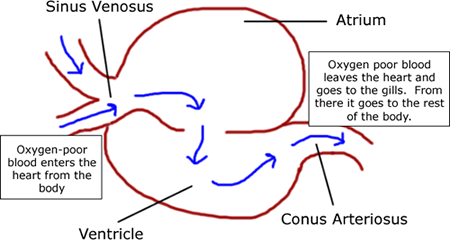Fish Form and Function

Fish Characteristics
-
Gills: They breathe through gills, extracting oxygen from water. Gills are feathery structures that facilitate the exchange of gases.
-
Fins: Fins help fish maneuver, maintain balance, and propel themselves through the water. Types of fins include dorsal fins, pelvic fins, anal fins, pectoral fins, and caudal fins (tail fins).
-
Scales: Most fish have scales covering their bodies. These scales protect them and reduce friction as they move through water.
-
Ectothermic: Their body temperature adjusts according to the temperature of the surrounding water.
-
Swim Bladder: Many fish have a swim bladder, an internal gas-filled organ that helps them control their buoyancy and stay at a certain depth in the water. (Sharks do not have swim badders.)
-
Vertebrates: They have a backbone, part of the vertebrate group, which separates them from invertebrates.
-
Reproduction: Most fish reproduce by laying eggs, though some give birth to live young. They typically release eggs and sperm into the water for external fertilization.
-
Aquatic Habitat: Fish live exclusively in water, inhabiting various environments such as freshwater, saltwater, and brackish water.
-
Varied Diet: Fish exhibit diverse feeding habits. Some are carnivorous, eating other fish or small aquatic creatures, while others are herbivorous, feeding on plants and algae.
Evolution of Fishes
-
Early Fish-Like Organisms: The first fish-like creatures evolved around 500 million years ago during the Cambrian period. These early organisms, like Pikaia, displayed some primitive characteristics of fish, such as a simple backbone-like structure.
-
Jawless Fish (Agnatha): Among the earliest true fish were the jawless fish, known as agnathans, which appeared around 470 million years ago. These fish lacked true jaws and were represented by groups like ostracoderms and the living lampreys and hagfish.
-
Jawed Fish (Gnathostomes): Around 420 million years ago, fish with jaws (gnathostomes) emerged. This significant development allowed for more effective feeding and predation. One of the earliest jawed fish groups was the placoderms, followed by the cartilaginous fish (sharks, rays) and bony fish.
-
Bony Fish (Osteichthyes): Bony fish, characterized by their bony skeletons and the presence of scales, evolved around 420 million years ago. This group includes ray-finned fish (Actinopterygii) and lobe-finned fish (Sarcopterygii).
Fish Anatomy
Feeding - Heterotrophs (carnivores, herbivores, omnivores, detritivores, parasitic)
Respiration
- Gills and Gill Covering (operculum)
- Lungfishes (air-breathers)
Circulation
- Closed Circulatory System, Single Loop
- Atrium --Ventricle -- Gills -- Body -- Back to Atrium


Excretion
- Salt water fish tend to lose water
- Fresh water fish tend to gain water
- Homeostasis maintained by the kidneys
Response
- Cerebrum - thinking, voluntary activities
- Cerebellum - coordination
- Medulla Oblongata - functions of internal organs
- Lateral Line System - senses vibrations
Movement
- Paired Fins for steering
- large caudal fin for forward motion
- Swim Bladder - buoyancy
FINS
Caudal - tail, forward motion
Dorsal - backside; stability
Anal - near anus; stability
Pelvic - underside, near or below pectoral fin
Pectoral - side of fish, near gills; steering

Reproduction
- Oviparous (lays eggs)
- Ovoviviparous (eggs stay in mom)
- Viviparous (babies get nourishment from mom. Ex. Humans, cats, some
fish)
Groups of Fish
Download or Open in Google Slides
Kingdom Animalia
...Phylum Chordata
......Subphylum Vertebrata
Classes of Jawless
fish:
- Lamprey (parasitic)
- Hagfish (scavenger)
- Both have cartilage skeleton
Class Chondrichthyes
- Cartilage Fish
- Sharks, stingrays
- Most are predators
- Basking sharks are filter feeders
- No swim bladder, pectoral fins rigid

Class Osteichthyes
- Bony Fish
- Ray-finned ( Goldfish, Bass, Carp, Salmon ) & Lobe Finned ( Coelacanth
)

Fish Activities and Assignments
